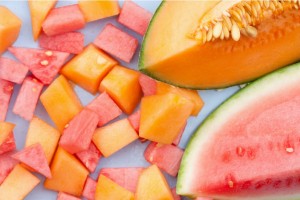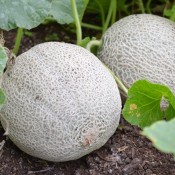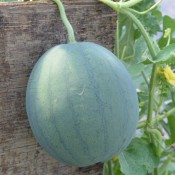
Cucumis melo.
Melons are members of the large family of gourds or pumpkins, which grow on trailing vines. There are thousands of varieties and range in size. Melons are considered to be a fruit, but are often used as a vegetable. The wild ancestors of this species seem to have been native to the region stretching from Egypt to Iran and northwest India.
Melons fall into two main categories: summer fruits, which include all those varieties with netted rinds; and winter melons, which have a smooth or finely ridged rind that is smooth or finely ridged.
Summer melons are also known as dessert melons. Varieties include the following:
- Cantaloupe
- Galia
Winter melons are so-called because they ripen slowly and are not ready until late fall. They are elongated, and their skins can be smooth or ribbed lengthwise. Some popular varieties include the following:
- Honeydew
- Casaba (Cucumis melo var. inodorus)
Melons make great patio climbers, but they do need some support as they grow. Otherwise, they can be left to grow as a ground-cover crop through ornamental beds and borders. They grow best in full sun in a warm location. The soil should be average to fertile, humus-rich, moist, and well-draining. Fruit develops poorly with inconsistent moisture and plants can rot in cool or soggy soil. To improve drainage, use raised beds or mound soil up before planting. Melons bear male flowers first. Female flowers will usually appear a week after and tiny melons will form just below the base of the flower. They prefer plenty of water during the growth and early fruiting stages. As the fruit is ripening, cut back on watering, the fruit tends to be more flavourful and sweeter. When the melon crop is finished, the leaves are good for the compost because they are full of calcium.
Melons make wonderful companion plants for corn, marigolds, nasturtiums, pumpkin, radish, squash, and sunflowers. Melon should not be planted near potatoes.
See here for Watermelon.
| Nutrition | Melons have very high water content, therefore, low in calories. The more orangey the flesh, the more carotenes it will contain. They are high in vitamins A and C; fair source of folacin, vitamin B, magnesium and other minerals. |
|---|---|
| Harvesting | Generally, melons do not become sweeter after harvesting so they should be allowed to fully mature on the vine. Cantaloupes develop more netting on the rind as they ripen. They “slip” easily from the vine with gentle pressure when ripe, meaning that the vine naturally detaches from the fruit. |
| Storing | Keep ripe melons in the refrigerator for up to a week. |
Varieties Listing
This vigorous, dependable and early maturing variety bears 5 – 6 pounds (2 – 3 kg) fruit with outstanding flavour and aroma. With firm, deep salmon-orange coloured flesh and small seed cavity, Athena has excellent yields and a good shelf life. This variety is very popular with market growers because of its exceptional quality and… Read more »
Sugar Baby is a popular 1959 heirloom variety that is dark green and sweet. “Baby” is a term for those fruits that average under ten pounds. This early variety is a small-fruited “ice-box” type bearing 6-8” (15 – 20cm) in diameter fruit weighing 6 – 10lbs (2.7 – 4.5 kg). The hard rind turns green-black… Read more »
Back to Organic Edibles.


